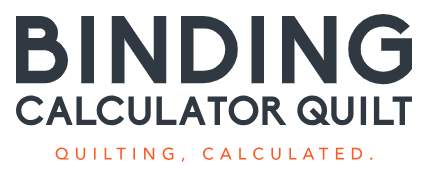Backing & Batting Calculator
Calculate exactly how much backing fabric and batting you need for your quilt project, including panel layout and seam placement.
Backing & Batting Calculator
Quilt Top Dimensions (Finished)
Enter the finished size of your quilt top (after quilting)
Overhang (Extra on All Sides)
Backing and batting should be larger than your quilt top to allow for shifting during quilting
Longarm quilters typically need 6" overhang
Backing Fabric Settings
Wide backing eliminates seams
If panels needed
For joining panels
Understanding Quilt Backing & Batting
Why Does Backing Need to Be Larger Than the Quilt Top?
Your backing fabric needs to extend beyond your quilt top on all sides to accommodate the quilting process. During quilting, the layers can shift slightly, and having extra backing ensures:
- You won't run out of backing fabric if the layers shift during quilting
- There's enough fabric to grip when loading onto a longarm or frame
- The edges remain secure when using a walking foot or free-motion quilting
- You have room to square up the quilt after quilting is complete
How Much Overhang Do You Need?
- Domestic Machine Quilting: 4-5 inches on all sides is typically sufficient
- Longarm Quilting: 6-8 inches on all sides to accommodate the frame clamps
- Hand Quilting with Hoop: 4-5 inches provides enough grip for the hoop
- Hand Quilting with Frame: 3-4 inches is usually adequate
More overhang is always safer than less. You can trim excess backing after quilting, but you can't add it back if you run short.
Understanding Backing Fabric Widths
Quilting cotton typically comes in these widths:
- Regular Cotton (42-44"): Most common; usually requires seaming for larger quilts
- Wide Cotton (54-60"): Available from some manufacturers; reduces seaming
- Extra-Wide Backing (90-120"): Specifically designed for quilt backing; minimal or no seaming needed
Wide backing fabric costs more per yard but can save time and eliminate seams. Regular cotton is more economical but requires piecing for most quilts.
Choosing Seam Orientation
When your backing requires multiple panels, you can orient the seams either vertically or horizontally:
Vertical Seams (parallel to quilt length):
- Most common approach
- Typically uses less fabric for rectangular quilts
- Seams run up and down the quilt
Horizontal Seams (parallel to quilt width):
- Better for very wide quilts
- Can be more fabric-efficient for some dimensions
- Seams run across the quilt
Our calculator shows you both options so you can choose the most economical approach for your specific quilt.
Tips for Piecing Backing Fabric
- Seam Allowance: Use a 1/2" seam allowance for durability (our calculator accounts for this)
- Press Seams Open: Reduces bulk and makes quilting easier
- Avoid Center Seams: If using 3 panels, make one panel wider than the others to avoid a center seam
- Match Grain: Ensure all panels have the grain running the same direction
- Pre-wash Consistently: Either pre-wash all backing fabric or none of it
- Creative Piecing: Consider using leftover fabrics or creating a pieced design on the back
Understanding Batting Sizes
Batting comes in standard pre-packaged sizes that correspond to common bed sizes:
| Size Name | Dimensions | Best For |
|---|---|---|
| Crib | 45" × 60" | Baby quilts, wall hangings, small lap quilts |
| Twin | 72" × 90" | Twin bed quilts, lap quilts, table runners |
| Full/Double | 81" × 96" | Full bed quilts, generous lap quilts |
| Queen | 90" × 108" | Queen bed quilts, most common size |
| King | 120" × 120" | King bed quilts, large quilts |
Our calculator recommends the smallest standard batting size that will fit your quilt with backing overhang included.
Joining Batting Pieces
If no standard batting size fits your quilt, you can join two pieces of batting together:
Butting Method (Recommended):
- Lay batting pieces edge to edge without overlapping
- Use a large zigzag stitch or herringbone hand stitch to join the edges
- The join should be flat with no bulk
Overlapping Method:
- Overlap batting pieces by 1-2 inches
- Trim away half the thickness from each layer in the overlap area
- Hand stitch or zigzag the thinned area together
Pro Tip: Many quilters prefer to purchase batting by the yard from a bolt, which allows you to get exactly the size you need without joining.
Helpful Tips
- Buy Extra: Always purchase at least 1/4 yard more backing fabric than calculated to account for shrinkage and cutting errors
- Check Fabric Width: Measure your actual fabric width; it can vary from the stated width
- Pre-wash Consideration: Pre-washing can shrink fabric by 3-5%; factor this in if you pre-wash
- Directional Prints: With directional or large-scale prints, you may need extra yardage for pattern matching
- Batting Loft: Higher loft batting requires more backing overhang; adjust accordingly
- Off-Center Seams: For a professional look, avoid placing seams directly in the center of the backing
- Fusible Batting: If using fusible batting, follow manufacturer's instructions for fusing
Common Mistakes to Avoid
- Not adding enough overhang for your quilting method
- Forgetting to account for seam allowances when piecing backing
- Using different fabric widths without recalculating panel requirements
- Not pressing seams open, which creates bulk
- Cutting batting too small and having to join pieces unnecessarily
- Not checking if the backing fabric is wide enough before purchasing
- Mixing pre-washed and non-pre-washed fabrics in the same backing
